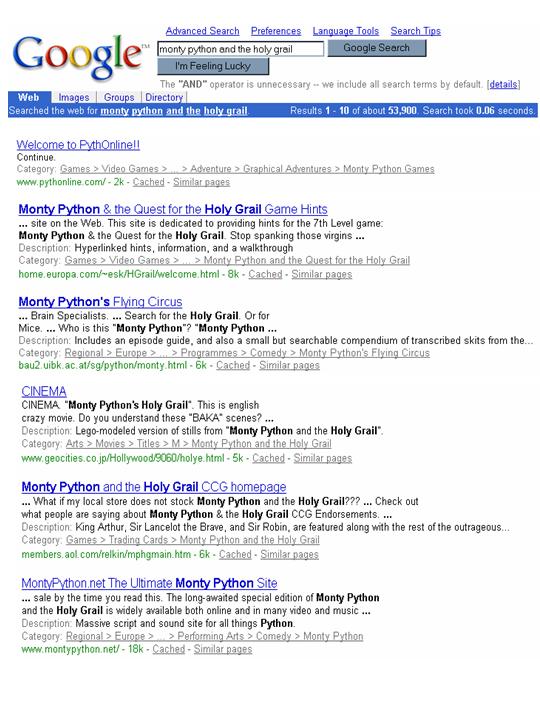A recent Biznology article by Frank Reed talks about the impact of a Google search results change on search engine optimization efforts. Google recently announced two changes in the way it helps users understand how an item in its result set fits into the context of the destination site:
- Replacing the URL (that appeared after the abstract) with a breadcrumb. The breadcrumb is a combination of domain name and the site hierarchy that Google has extracted from the site.
- Having each element of the breadcrumb go to the appropriate high level section of the site. What was once a single URL (was it a link or just a URL?) to the page could now be several links to higher-level pages on the destination site.
Frank worries about how this affects SEO activities: you work hard to get a specific page listed for a specific search term, and then Google lets the user go to a different page on your site. It will be interesting to see how this shakes out.
Of course, I am more interested in the breadcrumb aspect. These are what I call "attribute breadcrumbs" because they help describe the nature of the object. (The debate about the value of location breadcrumbs on pages continues.)
I wonder if anyone on the Google team remembers back around 2002 when their results also had breadcrumbs? In those days, the breadcrumb was a "category" from the Open directory project. Here is an example I grabbed back then, for a search on "monty python and the holy grail":

Look for the "Category" links after the abstracts and before the green URL. They give you a clue to what the link is about. Notice the first result, for PythOnline: the title and abstract are not clear but the Category says it is about a video game. The 3rd result is actually about Flying Circus; the 4th result is indeed about the movie; the 5th, trading cards. The category, presented as a breadcrumb, might help you find your holy grail...
Back then, the "category" was a single link to ODP, not a list of links to the destination site. For example, the 4th result would be Arts > Movies > Titles > M > Monty Python and the Holy Grail where you can find more links about the movie.
Will this version of breadcrumbs survive longer? Does it fix some key problem the previous version of breadcrumbs had? Perhaps users are more familiar with presenting a hierarchy in this format now? Will users understand the "..." in the middle? What user research is driving this change? The Google blog posting says this will both improve the way it represents web sites and help users explore content. I guess time will tell.
And what will the ripple effect be of Google using attribute breadcrumbs on its search engine results page (SERP)? Will more sites start doing breadcrumbs as a result ("Google told us to add breadcrumbs to our site")? What about multi-faceted web sites that do not have a single hierarchy for their pages: will they be penalized by Google? Will users start to pick up on them on SERPs and expect them on the rest of the web? When user experience teams do evaluations of their web sites, will they notice more users making comments about breadcrumbs? Will sites built on platforms like Drupal that do breadcrumbs well see a boost in traffic? Will there be a backlash against bothering with carefully-crafted URLs if they do not show up on SERPs any more?
This new feature has not appeared on any normal Google searches I have done since the announcement, so obviously, it is still too early to tell. According to This week in search, 11/20, there are some queries where the attribute breadcrumbs are showing up. My favorite is Venn diagram (too funny given the number of 3 circle diagrams generated by the user experience community). What I notice:
- Only a few items have breadcrumbs instead of URLs.
- When the green URL is shown, it is never clickable (was it before?). When an attribute breadcrumb is shown, the domain name is not a link either.
- The most interesting example is Wolfram MathWorld where the site has three location breadcrumbs at the top and Google used the first. Exactly how Google extracts breadcrumbs from pages could drive some "interesting" changes to sites.

Recent comments